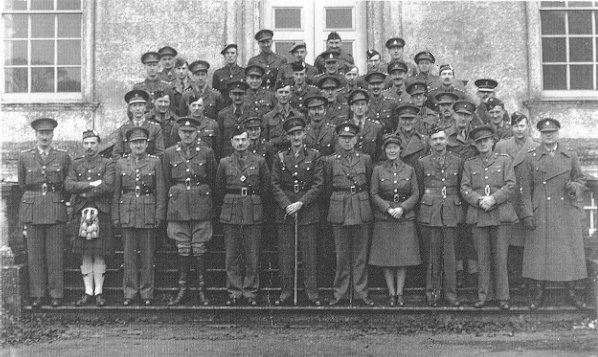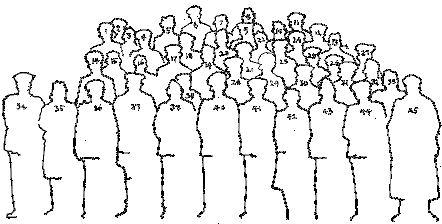HISTORY
Even before the war, some thought had been given by the War Office to the creation and arming of guerrilla units and several people can claim, with some justification, that they originated the proposal. However, the credit for taking up and implementing this idea must be given to a Major Gubbins, (later to become Sir Colin Gubbins and to achieve fame as the head of SOE). In 1939, he was working for Department MI(R), Military Intelligence (Research), and had carried out studies and written reports on guerrilla warfare. Early in the war, he was involved with the Independent Companies and took several of these units to Norway for the abortive 1940 campaign.
On his return to Britain in June 1940 and now a Colonel, he was instructed to create an underground army which would form the nucleus of a resistance movement in the event of a successful occupation of all or part of the UK by German invasion forces. This organisation was to be known by the codename of 'Auxiliary Units' and was to come under the direction of GHQ Home Forces, whose Commander in Chief, at that time was Field Marshal lronside.
Initially Gubbins requested and was given the support of some dozen officers, hand-picked from those known personally to him and on whom he could rely to 'get on with the job'. These were known vaguely as 'Intelligence Officers' and were to form the Regular Army units who were to be responsible for the organisation and local training of the proposed resistance movement.
The Auxiliaries themselves were all to be part-time volunteers, recruited from members of the recently formed Home Guard, and Gubbins was given the authority to requisition suitable men. These recruits varied in age and occupation, from young students, factory workers in reserved occupations, miners and farmers, to professional men like doctors and accountants. Age was no barrier, as long as the recruit was fit and capable of existing under the harsh conditions anticipated. Gamekeepers and countrymen of all sorts were much sought after, as well as those with experience of Scouting and woodsmanship.
The recruits were told that they were being selected for special Home Guard duties, and were being 'posted' to one of three battalions, numbered 201 (Scotland and Northern Counties), 202 (Midlands) and 203 (London and Southern Counties).
Whilst these men honestly believed that they were in the Home Guard, this was purely a cover, and they were never officially registered as being members. Since they were not enrolled as fighting men, they were not strictly covered by the Geneva Convention, although their uniform may have given them some degree of protection against being shot out of hand if captured. It is known that likely recruits were vetted before being approached. Gubbins had arranged for this to be done by plain clothes or Special Branch police officers who made discreet enquiries from employers or neighbours without knowing or stating the purpose of the enquiry. Once recruited, volunteers were subject to the Official Secrets Act, and their wives and families were largely unaware of the special duties in which they were involved. The movement was organised on the cell principle, the cell being a patrol of some five or six men led by a sergeant. A volunteer Group Leader, given the rank of a Home Guard Lieutenant or Captain, would be responsible for several such patrols within a ten or fifteen mile radius of his home, and certainly in the early days, this was the only contact between individual patrols. By September 1940, the Auxunits were firmly established. Gubbins anticipated that any successful invasion would be seaborne and he set up his resistance units within the coastal belt, extending from South Wales, around the Southern Counties, up the East Coast, and as far north as John O’ Groats, with an obvious preponderance of units in Dorset, Hampshire, Sussex and Kent. Eventually there were patrols all over the UK extending inland as far as Manchester and Hereford, and by late 1941 nearly 600 had been formed, comprising over 3,500 Auxiliaries. By this date, most counties had their own Intelligence Officer, who was often stationed in his home county because of his contacts. Amongst these regular officers was the actor, the late Sir Anthony Quayle, who was Intelligence Officer for Northumberland. Each Intelligence officer was given a platoon of some dozen NCOs and men, to help him with the supervision, distribution of supplies to and local training of the Auxunit patrols in his area.


A photograph of officers serving with Auxiliary Units, taken at Coleshill on 29 January 1942. No record of the names of the people in the photograph was kept, but it has been possible to identify most of them. Where there is any uncertainty, the name is preceded by an asterisk.
1 *Captain Lamb ; 2 ____ ; 3 ____ ; 4 Captain J. W. S. Edrnundson ; 5 Captain A. G. Fiddes-Watt ; 6 Captain Anthony Quayle ; 7 Captain G.R. McNicoll ; 8 Captain C. Sandford ; 9 * Captain J.W. Holberton ;10 Captain R.F.H. Darwall Smith ;11 ____ ; 12 Captain J. Dingley ; 13 Captain W.D. Clark ; 14 Captain R.J.V. Goss ; 15 Captain C. Woodward ; 16 Captain N.V. Oxenden, MC ; 17 ____ ; 18 Captain G.C.L. Atkinson, MC ; 19 Captain P. Hollis ; 20 Captain P.R.A. Forbes ; 21 ____ ; 22 ____ ; 23 ____ ; 24 Captain E.R.R. Fingland ; 25 Captain E.B. Clive ; 26 ____ ; 27 Captain O.B. Hall-Hall ; 28 Captain K. W. Johnson; 29 ____ ; 30 *Major Lord Ashley ; 31 Captain Ian Fenwick ; 32 Captain C.F.G. Bond ; 33 *Captain D.F.B. Stucley ; 34 Major W.W. Harston ; 35 Captain E. Maxwell ; 36 Captain A.R.C. Anderson ; 37 Major The Hon. M.T. Henderson ; 38 Lieut.-Col. G.H.B. Beyts, MC ; 39 Junior Commander Barbara Culleton ; 40 ColoneI C.R. Major ; 41 Major M. Petherick, MP ; 42 Senior Commander Beatrice Temple ; 43 Major T.H. Winterborn ; 44 Captain C.E. Randell ; 45 Captain J.S. Collings
Roll taken from The Last Ditch, David Lampe 1967, reprinted 2007 by Greenhill Books.
Explosives, Booby Traps, Incendiaries
Return to Auxunit News